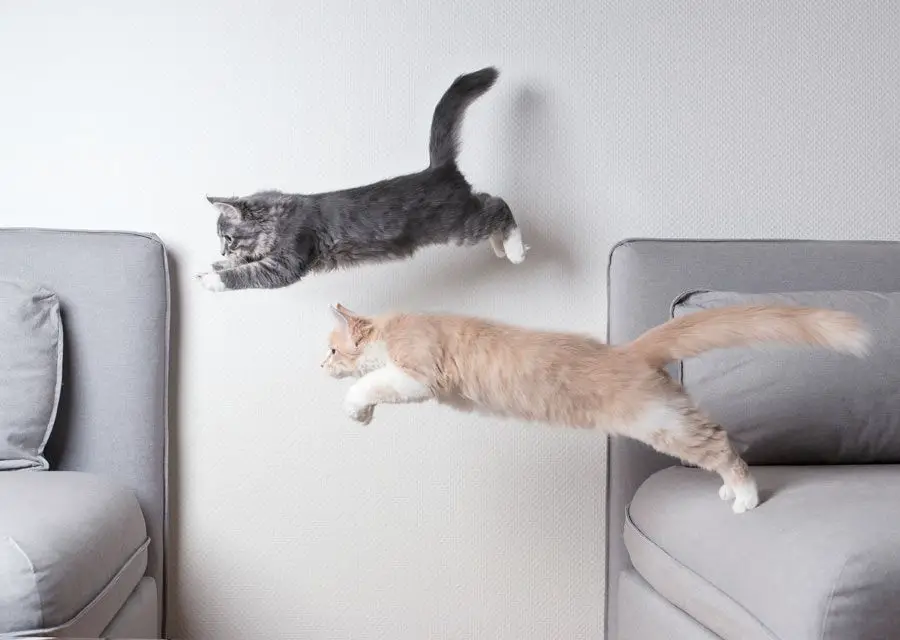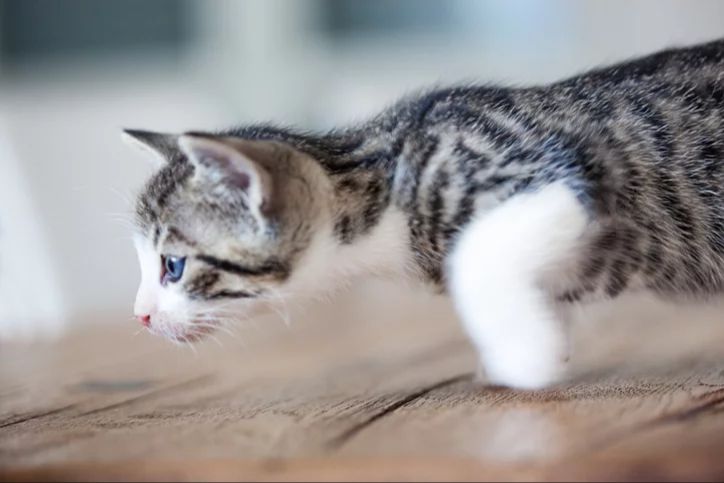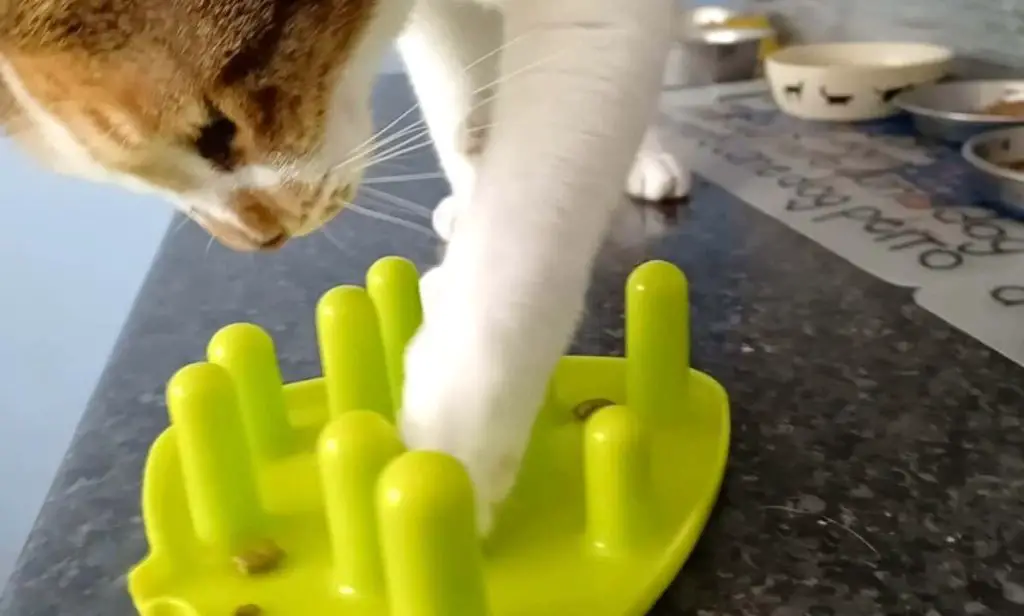What Are Cat Zoomies?
Cat zoomies are periods of sudden, frenzied activity in which a cat will sprint, jump, and playfully chase around the house at top speed, often skidding when taking sharp turns or spinning in circles. This frantic yet joyful behavior has been described as a feline burst of energy or kitty crazies. It’s most commonly witnessed in younger cats and kittens, although cats of any age can experience zoomies.
During zoomies, cats will often run laps around rooms, up and down stairs, jump on and off furniture with their pupils dilated. They may playfully chase toys, swat at invisible prey, or skid to a stop only to zoom off in another direction a moment later. Owners describe it as watching their cat act possessed or go crazy for a brief spell before tuckering themselves out. While zooming, cats seem enthralled in play yet focused on an unseen activity.
Zoomies are considered normal cat behavior, not aggression. Experts believe domestic cats experience evolutionary remnants of predatory instinct and energy bursts benefiting survival in the wild. For indoor cats, brief zooming provides an outlet for their primal hunting urges when they lack sufficient mental stimulation or physical activity in daily routines.
While zooming appears random, various triggers may spur a zoomie episode, from an impending weather change, owner’s return home, successful hunt-like play session, or just excess energy to burn. Zoomies are temporary outbursts that end as fast as they started once a cat has sufficiently expended their pent up energy. After the excited frenzy, cats promptly return to calm and relaxed. Zooming is part of a healthy feline lifestyle providing joy, activity, and stress relief.
When Do Kittens Start Zooming?

Kittens typically begin exhibiting zoomies behavior around 6-8 weeks of age (Source). As their coordination and mobility improves, kittens start exploring their surroundings more actively. This newfound freedom and energy builds up inside them, resulting in bursts of frantic sprints, jumps, and play. Kittens generally zoom in short spurts, lasting only a minute or less.
Young kittens tend to zoom mostly in the mornings and evenings when they have peak energy levels. Zoomies upon waking up in the morning help kittens release pent-up energy after a long night’s sleep. At night, zoomies help expend energy before bedtime. Kittens may also zoom after mealtimes or potty breaks when feeling particularly playful.
Kittens zoom and play more frequently than adult cats. As they reach around 6 months to 1 year of age, zooming starts to decrease in frequency and intensity. But even as cats mature, zoomies remain a lifelong behavior that brings joy.
Why Do Cats Zoom?
There are several theories as to why cats experience bursts of frantic energy known as the zoomies:
Play – Kittens and young cats especially tend to get the zoomies when playing. Zooming around the house allows them to act out hunting behaviors and burn off excess energy. It’s a natural way for them to play and interact with their environment.
Hunting practice – Zooming allows cats to practice and hone their hunting skills. The quick sprints and abrupt stops mimic the movements required when chasing prey. It helps keep their skills sharp.
Releasing energy – Cats can zoom to release pent up energy. After napping or being cooped up, they may build up an energy reserve that needs to be spent. Zooming helps them expend that excess energy.
Stress relief – For some cats, zooming serves as an outlet for stress and anxiety. The exertion can act as a release for nervous energy.
Overall, most experts think the zoomies are an instinctual behavior that remains from cats’ undomesticated ancestors. It allows them to play, practice hunting, expend energy, and relieve stress – all natural behaviors for felines.
How Long Do Zoomies Last?
A typical zoomies episode usually lasts from a few minutes up to around 15 minutes, though some cats can zoom nonstop for longer periods. According to Reddit users, some cats may experience extended zooming for up to a few hours at a time, especially energetic young cats or after triggering events like using the litter box.
Most sources suggest that the average zoomies session ranges from 1-15 minutes of frantic activity before a cat tires itself out. Kittens and younger cats under 3 years old tend to have longer, more frequent episodes of zoomies that can last up to 30 minutes or more. As cats mature and reach middle age, the zoomies tend to become shorter and less common.
The duration of zoomies is influenced by factors like age, energy level, breed, and environment. But in general, cats can’t sustain the hyperactive zooming behavior for more than several minutes before needing to rest. The zoomies are intense physical and mental exertion for a cat, so the bursts of energy are usually brief but can be entertaining to watch!
Do Zoomies Decrease with Age?
Zoomies tend to decrease in both frequency and intensity as cats get older. According to Fetch Pet, most cats can’t sustain the frantic zooming behavior for more than a minute or so. As cats age, the “feline rapid anterior activity periods” (FRAPs) often get shorter and less frequent.1 By around 9-12 months old, kittens have started to calm down from the energetic kitten stage and their massive enthusiasm begins settling as their personality develops more.2

On Quora, some cat owners report their cats slowing down around 11-12 years old, while others don’t notice signs of slowing until much later, similar to how it varies in humans.3 So while zoomies do tend to decrease with age, there is individual variation in when and how much cats slow down. The key is knowing what is normal for your specific cat.
While zoomies may become less energetic, senior cats can still periodically enjoy the joy of running around. And there are ways to provide enrichment to keep older cats engaged. So zoomies don’t necessarily stop entirely with age, they just tend to decrease in frequency and intensity compared to the lively kitten phase.
Zoomies in Senior Cats
Zoomies can continue into a cat’s senior years, but may decrease in frequency and intensity compared to when they were younger. According to Cats.com, in senior cats, zoomies are sometimes a sign of dementia and cognitive decline related to conditions such as cognitive dysfunction syndrome (CDS) (https://cats.com/cat-zoomies). However, zoomies in older cats are often still simply a harmless expression of joy and energy release.
As cats age, their zoomies episodes tend to become shorter and less frantic. An older cat is more likely to have a brief burst of sprinting across the room, whereas a kitten may zoom wildly all over the house. Older cats also tend to sleep more and have lower energy levels in general. But zoomies can still erupt out of nowhere at any age when cats get a surge of energy. It’s usually nothing to worry about unless the episodes seem abnormally prolonged or frequent.
When to Be Concerned
While zoomies are usually harmless fun for cats, there are some signs that may indicate an underlying medical issue or concerning behavior. According to Hill’s Pet Nutrition[1], zoomies accompanied by signs like straining to urinate, blood in the urine, diarrhea, or excessive licking of the genital area could signal illness or discomfort in the urinary tract, colon, or rectum. Likewise, zooming with strained vocalizations or panting could point to distress or pain.
Aggression during zoomies is also problematic. Scratching furniture or people, knocking things over, or pouncing aggressively at humans suggests the cat may be overstimulated. Frequent zoomies late at night that disrupt sleep are similarly undesirable. If zoomies last for over 30 minutes at a time or occur many times per day, that may also warrant a vet visit to rule out any potential medical issues.
Overall, any concerning behavioral changes that accompany zoomies should prompt a call to your veterinarian. They can help determine if changes in diet, enrichment, or health may help manage unhealthy zoomies.
Managing Zoomies
Zoomies are a normal part of cat behavior, but they can become disruptive and annoying, especially at night. Luckily, there are some tips to help manage zoomies and meet your cat’s needs:
Make sure your cat is getting enough physical activity and playtime during the day – at least 15-30 minutes per day. Active play with toys like feather wands and laser pointers will help satisfy your cat’s natural instincts to hunt and pounce. This may help reduce zoomies at night. Provide puzzles, foraging toys, and climbing structures for mental enrichment as well.
Have scheduled, consistent feeding times rather than free-feeding. This can help regulate your cat’s energy levels throughout the day.
Trim your cat’s nails regularly to minimize damage if they zoom and scratch furniture or carpet. Cat scratching posts and cardboard scratchers can also help divert scratching behavior.
Try calming supplements like Feliway or calming treats/chews. These release pheromones and ingredients to help relax cats.
Block off unsafe areas like kitchen counters or balconies that a zooming cat could jump on and get hurt. Also secure fragile items and cover cords/wires.
Consider getting another kitten or cat so your current cat has a buddy to playfully chase and wrestle instead of zooming alone. But introduce them slowly and carefully.
Ignore zooming rather than scolding or reacting, as your cat may interpret any attention as rewarding, even negative attention. Redirect them gently instead.
Be patient and provide outlets for natural cat behaviors. With enrichment and routine, zoomies often decrease naturally as cats mature. But remember – zooming is a sign of a happy, healthy cat!
Enrichment for Older Cats
As cats age, it’s important to continue providing enrichment to keep their bodies and minds active. There are many easy ways to engage and stimulate older cats at home.
Puzzle feeders are a great way to make mealtimes more interesting. These feeders have maze-like designs that require cats to move pieces around and work for their food. This provides mental stimulation and keeps cats more active. Some popular puzzle feeder brands include Nina Ottosson and Trixie.

Hiding treats around the house for your cat to hunt and forage is another simple way to enrich their environment. You can hide treats in paper bags, cardboard boxes, puzzle toys, and other hiding spots to engage their natural hunting instincts. Just be sure treats are in easy-to-reach places for older cats.
Catnip and other herbs like valerian can reawaken interest in old toys. Sprinkle these enticing scents on toys or scratching posts to make them more appealing again. You can grow cat-safe herbs in indoor pots for easy access.
Giving cats access to perches, cat trees, windowsills, and other high vantage points allows them to observe activity outside. Outdoor bird feeders nearby also provide entertainment. Placing ramps or steps can help senior cats access these areas if mobility is an issue.
Rotating toys frequently to introduce novel items also prevents boredom. Interactive wand toys are ideal for getting cats moving and exercising, without requiring too much effort on their part. Avoid laser pointers, which can frustrate cats.
Incorporating enriching activities tailored for senior cats’ needs is important for keeping their bodies and minds stimulated as they age.
The Joy of Zoomies at Any Age
Though zoomies may decrease with age, they remain a beloved, joyful behavior in cats of all ages. The frenzied sprints, jumps, and playfulness of zoomies demonstrate a cat’s happiness and energy.
According to cat behavior experts, zoomies are a way for cats to release pent-up energy and express their natural hunting behaviors in a stimulating way (https://www.dailypaws.com/cats-kittens/behavior/common-cat-behaviors/cat-zoomies). Zoomies often occur after a nap or period of rest, as the cat has stored up extra energy.
Seeing a senior cat continue to experience zoomies into their older years can reassure cat owners that their pet remains active and content. According to veterinarians, zoomies past age 12 are a sign of good health and cognitive function (https://www.cats.org.uk/cats-blog/6-tips-for-preventing-cat-zoomies).
While zoomies may be tiring for owners, they are a joyful display of natural cat behavior. Enjoying your cat’s zoomies, regardless of their age, celebrates their energy and provides essential stimulation.

